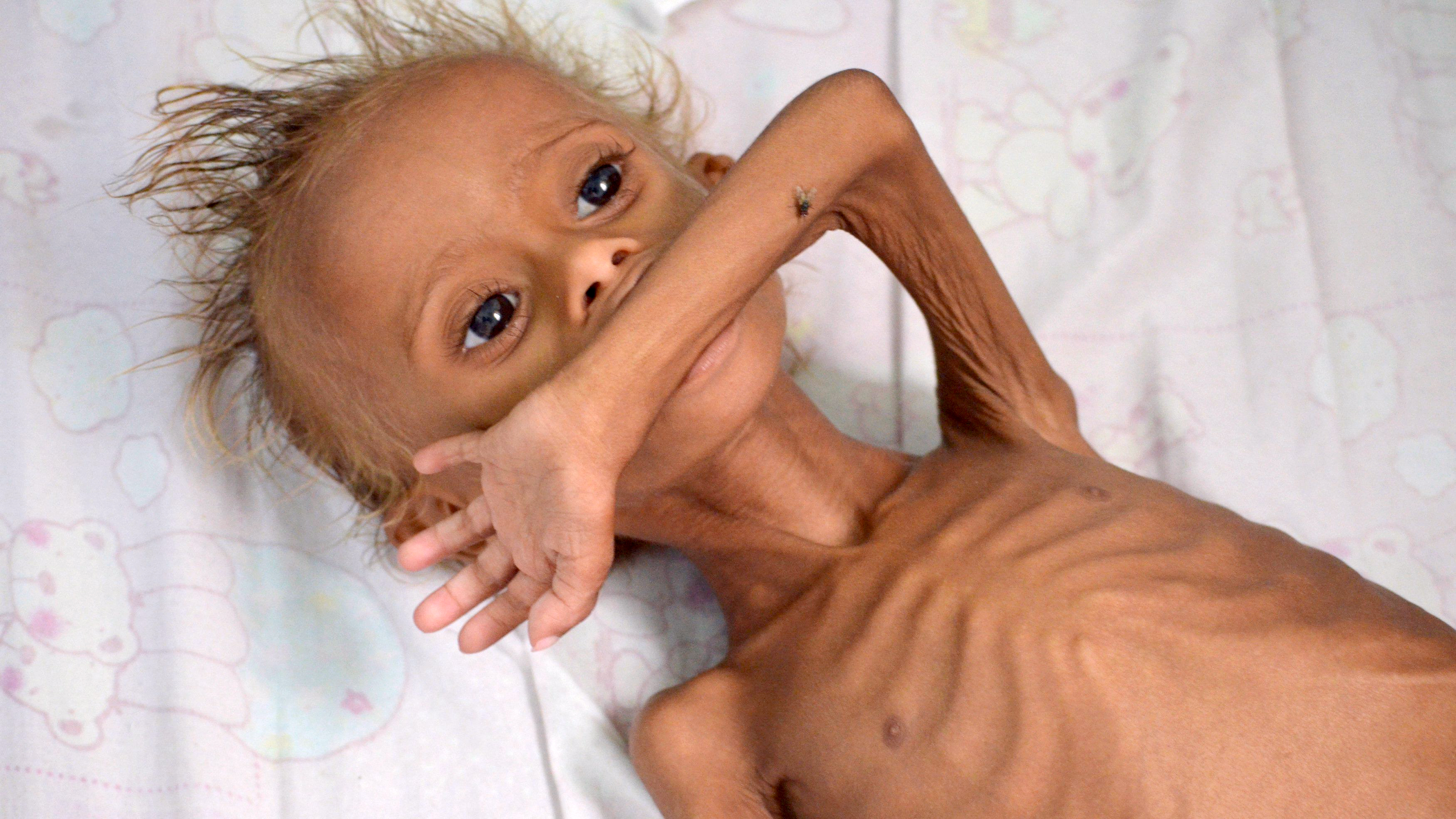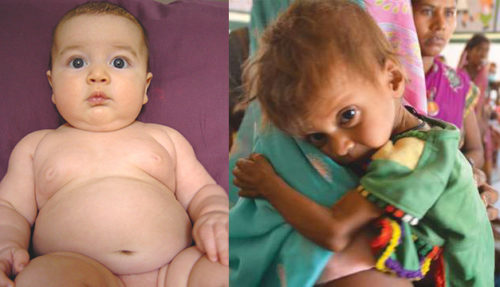Obesity, Underweight – Worldwide Craziness
Obesity is now more common in the world than being underweight! How crazy is that?
Global obesity numbers shot up over 600 percent between 1975 and 2014 and don’t look like they’re slowing down any time soon—is that crazy or not?
One year olds both, both malnourished
The number of people who fell into the category of Obese in 1975 was 105 million. In 2014 that number was 641 million, according to the most comprehensive body mass index (BMI) trend study done.
If you take the trouble to calculate the age-corrected proportions of men and women between those years, one finds that the percent of obese men climbed from 3.2% of the population to 10.8% and that of obese women went from 6.4% to 14.9%.
Obesity: Now More Prevalent Than Underweight
These figures world-wide are a bit of an effort to come up with so aren’t done every year; but, extrapolating from the rates we know, the world seems to be flipping on its head.
-
Classification BMI
- Underweight <19
- Ideal BMI 19-25
- Overweight 25-30
- Obese >30
- Severely Obese >35
- Morbidly Obese >40
- Super Obese >50
During the same 40-year period I mentioned above, the proportion of men who were underweight fell from 13.8% to 8.8%; and among women from 14.6% to 9.7%!
Clearly, that means that over a 40 year time frame [long after the “industrial age.” In an age that I’ll call the “industrial-marketing, advertising and fast food age”] we’ve gone from a world where the word MALnutrition has changed from meaning starved to meaning gluttonous.
A world where there were once twice as many starving people as obese people; into one where obesity doubles the number who are starving.
AND THAT IS NOT TO MEAN THERE ARE ANY LESS STARVING PEOPLE OVERALL!
Where Is This Going?
The statistics we’re talking about were gathered in order to support the World Health Organization’s (WHO) goal to halt obesity at its 2010 level by 2025; and it doesn’t look good for making the goal. Data came from the most significant 186 countries.

If the trend continues the numbers will be: 18% of men and 21% of women will be obese by 2025 worldwide. Heck, more than 6% of men and 9% of women will be even one category higher severely obese by then! That even means more women will be severely obese than in the category merely underweight!
Malnourished-hungry
Before this study, figures weren’t very specific but this time obesity and underweight were divided into more categories. Morbidly obese includes those 40 kg/m² and higher and underweight those less than 18.5 kg/m²—both very enlightening.
Numbers of people underweight were highest in South Asia: men at 23.4% (17.8-29.2%) and women at 24% (18.9-29.3%). And even though some progress has been made, more than 12% of women and 15% of men are underweight in Central and East Africa.
More than a fifth of men in Afghanistan, India, Bangladesh, Timor-Leste, Eritrea, and Ethiopia are underweight; and more than a fourth of the population of women in Bangladesh and India are underweight.
As regards to having the lowest age-standardized BMI for women, it is Timor-Leste at 20.8 kg/m²; for men it is Ethiopia (20.1 kg/m²).
Nearly half of the world’s underweight men and women live in India! (46.2% and 41.6% respectively)
How can we ever deal with such a worldwide problem?
Politics Helping Or Hurting
The problem of obesity and of hunger is convoluted at best. For example, many countries do have what might be called “conditional cash transfers” where the poor are offered income/food assistance upon some condition such as attending health clinics. Unfortunately, and perhaps unintentionally, that makes them both based on medicine and clinics when food choices are usually independent of that.
Somehow the food portion of aid needs to involve only healthier foods (like unprocessed grains/legumes, protein, fruits and vegetables) and purposefully preclude processed and “fast” foods—that is if you’re trying to solve obesity-malnutrition.
BUT, administrators of malnutrition programs in poorer countries are finding in their data, and reporting in their confusingly, back-handed sort of rhetoric that: “many, many less people are escaping being underweight than are becoming obese.” In other words: poor people in poor countries get hungry instead of fat.

That, however, is NOT the case in the richer countries: Poor people in rich countries get fat. In richer countries the poor are more likely to be obese than those better off. While in South Asia and Central and East Africa, “the poor remain thin to an extent that compromises health and economic productivity.”
Which means that: Fighting obesity in poor countries diverts money away from the problems of the poor and toward a problem experienced more by the wealthy!
Being underweight is associated with increased risk of morbidity, mortality, and adverse pregnancy outcomes. Poverty-related low BMI can affect offspring for generations.
Malnourished-Obese
Looking at the other side of the malnourished coin, the study had revelations about those too. It was a so-called “meta-analysis” of 1,698 previous studies of 19.2 million people around the world 18 and older—all with enough information to calculate BMIs.
Only in 6 locations of the world did women have no increase in BMI (i.e. get more obese) over the 40 year time span: Singapore, Switzerland, Japan, the Czech Republic, Belgium, and France. Are these the places where people are more likely to eat fresh and unprocessed foods and to eat in moderation with an active lifestyle?
This knowledge makes the bean-counting administrators and politicians relieved cause it means that it’s probably possible to “legislate” or “price-manipulate” people out of obesity. If they can just figure out a way to tax obesity the politicians will think they’re in heaven!
Who has the highest average BMI in the world? Polynesia and Micronesia where more than 38% of men and over half of women are obese. So much for the laid back and simple life-style.

It truly isn’t surprising to anyone actually living on the grid that 20% of the world’s obese adults and over a fourth of the severely-obese live in six high-income countries: Australia, Canada, Ireland, New Zealand, the United Kingdom, and the United States—over 118 MILLION people!
More than one in four severely-obese men (27.8%) and 18.3% of severely-obese women in the world live in the United States!
The craziness is so confusing and the solutions so perplexing there are those who are willing to throw up their hands and decry that “the most effective intervention for weight loss” may be bariatric surgery—especially the plastic surgeons.
The malnourished-hungry are NOT people we can just give up on. We cannot just stand by and watch them starve.
The malnourished-obese issue, at the current time, is not solvable at the global level. It’s individual patients getting their heads out of the sand and smartening up to the gimmicks and manipulations in their lives about convenience. It’s, perhaps, local legislation against NOT the victims but the perpetrators of the epidemic.
It’s unrealistic to think we’ll make the WHO’s obesity targets but “Ambitious goals have a role in creating action and showing the work that is needed.” Who knows, the world has plenty and to spare of obese people as well as some very smart people. The two just could accidentally meet some day and come up with out of the box solutions to the problem.
12 Posts in Obesity (obesity) Series
- Five Diseases Reduced by Excersize – 7 Apr 2019
- Obesity now more common in world than being underweight – 18 Apr 2018
- BIG SODA, advertising conflict of interest – 2 Nov 2016
- Where does the fat go? – 9 Feb 2016
- Teens - Treadmill Dance to fight obesity and get fit – 1 Feb 2016
- 10 Ways To Ditch Obesity – 24 Jan 2016
- Fast Food – 16 Jan 2016
- Video: How to make our day harder - to expend more energy – 1 Dec 2015
- Type 2 Diabetes - Some Odd Possible Correlations – 6 Nov 2015
- Gastric Band Last Resort for Teen Obesity – 17 Aug 2015
- Obesity in Toddlers and Sugar-Sweetened Drinks – 10 Oct 2013
- Obesity Series: Intro/Index – 9 Oct 2013

